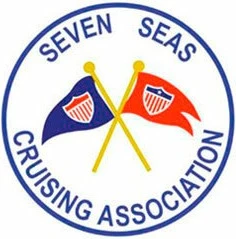
When I teach seamanship classes, inevitably somebody raises their hand and asks about how "flat" the boat should be. I say, "By 'flat' I'm guessing that you mean relative to her waterline. But do you mean when she is sitting at the dock, going slowly forward but only at a 'slow bell,' or making all deliberate speed?" As their eyes glaze over, I know that we will have to take it by the numbers. This column is about that.
For those who don't know, a "slow bell" means making way at the minimum speed at which the boat can maintain steerage. Larger boats, with exposure to the wind, need more speed to maintain steerage than a smaller, low-profile boat.
Boat Trim
Understanding boat trim and boat squat are all about control and avoiding running aground. For a "planing boat," i.e., those boats we're most familiar with that buzz around the bays and creeks, usually with an outboard engine on the stern, that "climb up" onto the water as they go faster, trim is synonymous with every aspect of the boat. Whether it be at the dock, barely making way, or operating "at speed", how 'flat' she rides is largely under the control of the skipper and he or she should be constantly aware of what trim they are assuming. This trim is best controlled by what angle you place the outboard engine relative to the transom. Huh?
Usually, in the throttle, there is a thumb control that when you press it "down", it brings the propeller in closer to the transom. See figure 1.

By bringing the propeller in closer to the transom, you force the bow down from its manufactured waterline. When would you want to do that? How about if you were heading into strong wave action? If your bow was trimmed 'up,' the force of the waves would accentuate that, possibly making it more difficult to see – and to control the boat.
Commensurately, if you press the thumb control to bring the engine "up," it moves the propeller away from the transom, forcing the bow up from its manufactured waterline.

Why would you do that? Well, there are a number of reasons. One reason is that a powered vessel's fuel consumption improves as you reduce its wetted surface. So, as you are cruising down the bay, you can trim the engine up and save fuel at a given rate of speed. Secondly, if you are willing to throw fuel efficiency to the wind, sort to speak, a powered vessel simply goes faster with less of a wetted surface. And, as you bring the bow up, you reduce the wetted (in the water) surface. Compare how much more of figure 1 is below the water line, versus figure 2.
Boat Squat
Unless you are driving one of those "battlewagons" out there, or are involved in commercial navigation, you've probably never heard of "boat squat." Even if you are in those situations, you still may not have heard of it – and it is critical to understanding why a boat with 4' of draft hits the bottom in 5' of water…
When any boat is making way through the water, she starts by pushing a large amount of water ahead of her. If she a planing vessel, she'll climb up on that wave as she picks up sufficient speed. But if she is a "big 'un", she won't be planning any time in this lifetime. She is a displacement vessel. So, this water that is getting pushed ahead returns to the side and under the boat's bottom. As she starts to put on some way (speed), imagine this cycle of water building up speed under the ship. This causes a drop in water pressure under the boat. This causes the ship to vertically drop in the water. This is "boat squat" and how a boat with 4' of draft hits the bottom in 5' of water. (Hint: go slow in shallow water, Big 'Un.)
Now, for a displacement vessel, trim is different from squat. Trim is the difference of the forward and aft draft while the boat is stationary. As she gets underway and her aspect to her water lines changes, she is affecting "squat." Naval architects justifiably worry about whether she has forward or aft "squat" (leans forward or aft as she builds speed.) This is largely determined by her center of gravity and her "block coefficient," which is the volume of the hull (V) divided by the Length of her Water Line (LWL) times the (maximum) Beam of her Water Line (BWL) times her Draft. If you draw a box around the submerged part of the ship, it is the ratio of the box volume occupied by the ship.
So, now, you can say that you do know squat!
If you Have any questions about this column or if you are interested in being part of USCG Forces, email me at [email protected] or go directly to the US Coast Guard Auxiliary "Flotilla Finder" at http://www.cgaux.org/units.php and we will help you "get in this thing."











